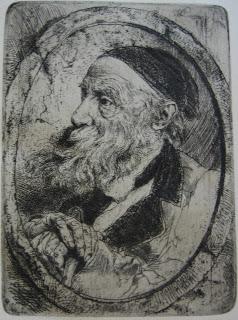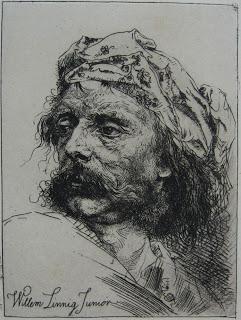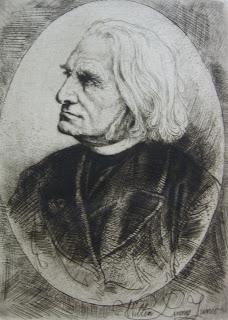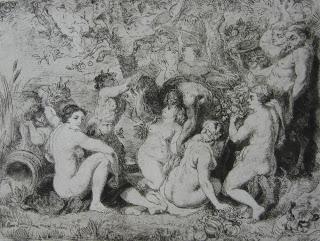First of all - apologies to all readers of this blog for the long time-lapse. Life has been difficult, and I was simply unable to keep going. But I hope this new post will be the first of many - perhaps one a month, not one a day like some manic bloggers!
Why have almost none of us ever heard of Willem Linneg, Junior, and why do I say he was born out of his time? Of course, he lived through the very same days and years as anyone else born in 1842 who died in 1890. Not a long life - he died aged 48 - but a very productive one. A great many paintings, and 123 listed etchings, of which I have 4 to share with you. But Monet was born in 1840, Renoir in 1841, Pissarro in 1830. Does Willem Linnig, Junior, show any sign of having heard of any of these artists? No, he does not. He looks back - back to the Flemish Golden Age, and back to the French artists of the 18th-century. So no wonder he has fallen through the cracks of art history. Yet I am intrigued by his work, and hope you will be too.
 Willem Linnig, Junior: Portrait de Preller(Porträt Friedrich Prellers, Portrait of Friedrich Preller)Etching, 1881Linnig 70
Willem Linnig, Junior: Portrait de Preller(Porträt Friedrich Prellers, Portrait of Friedrich Preller)Etching, 1881Linnig 70Linnig came from a dynasty of celebrated Belgian artists, whose output was surveyed in a 1991 exhibition, with a catalog by P. Verbraeken et. al., Linnig: Ein Antwerpse kunstenaarsdynastie in de 19de eeuw. His father, also Willem Linnig, and his uncles Égide Linnig and Jan Theodor Linnig, were all successful painters. But none of them were artistic daredevils, and it was in their studios (especially that of his father) that Willem Linnig, Junior, learned his trade. He did briefly attend the Antwerp Academy, to study under Verschaeren, but was a difficult pupil. He was booted out by the Director, Nicaise de Keyser, with the words, "Go, you'll never be a painter."
 Willem Linnig Junior: Head of a Gypsy(Kopf eines Zigeuners)Etching, 1882The catalog of Linnig's etchings in French does not give a precise match for this.I assume this may be Linnig 67, Le contrabandier, but have no proof.
Willem Linnig Junior: Head of a Gypsy(Kopf eines Zigeuners)Etching, 1882The catalog of Linnig's etchings in French does not give a precise match for this.I assume this may be Linnig 67, Le contrabandier, but have no proof.Nevertheless, Linnig persevered. In 1876 he became a professor at the Grand-Ducal Academy of Weimar (Grossherzoglich-Sächsische Kunstschule Weimar), where he remained until 1882. Among his students were Herman Schlittgen, Paul Baum, and Leopold von Kalckreuth.
 Willem Linnig, Junior: Portrait de Liszt(Porträt Franz Liszts, Portrait of Franz Liszt)Etching, 1883Linnig 71
Willem Linnig, Junior: Portrait de Liszt(Porträt Franz Liszts, Portrait of Franz Liszt)Etching, 1883Linnig 71The best selection of paintings by Linnig that I have found online are the 18 paintings by him in the Koninklijk Museum voor Schone Kunsten, Antwerp. The best selection of etchings is the one in this post. The etchings were first catalogued by Pol de Mont in 1897, in De Vlaamse School, and subsequently by Benjamin Linnig in Paul André, Le Peintre Willem Linnig, Junior, 1907. This gives no precise dates for the etchings, so the dates given in this post are those in which the etchings were published in the Leipzig art revue, Zeitschrift für Bildende Kunst.
 Willem Linnig, Junior, after Peter Paul Rubens: Nymphes et Satyres(Dryaden und Fanisten, Nymphs and Satyrs)Etching, 1888Linnig 100
Willem Linnig, Junior, after Peter Paul Rubens: Nymphes et Satyres(Dryaden und Fanisten, Nymphs and Satyrs)Etching, 1888Linnig 100I don't think anyone would claim Willem Linnig, Junior (or Willem Linnig the Younger, or Willem Linnig II, as he is sometimes known) as a particularly important or influential artist. But his work has a mixture of carefulness and abandon that appeals to me. He traces the lineaments of his sitters with great care, and then throws himself into spiralling curls of hair, beards and moustaches, and a signature that is the definition of flamboyance. If he had really let himself go, what could he have achieved? There's a clue in the single interpretative etching among his tally of 123, a highly spirited romp through a painting by Rubens, of Nymphs and Satyrs cavorting. I really think this is my favorite among my four etchings by Willem Linnig, Junior, because it shows a freedom of line, an exuberance, that I feel was lurking underneath his elegant precision, just waiting to burst out.

